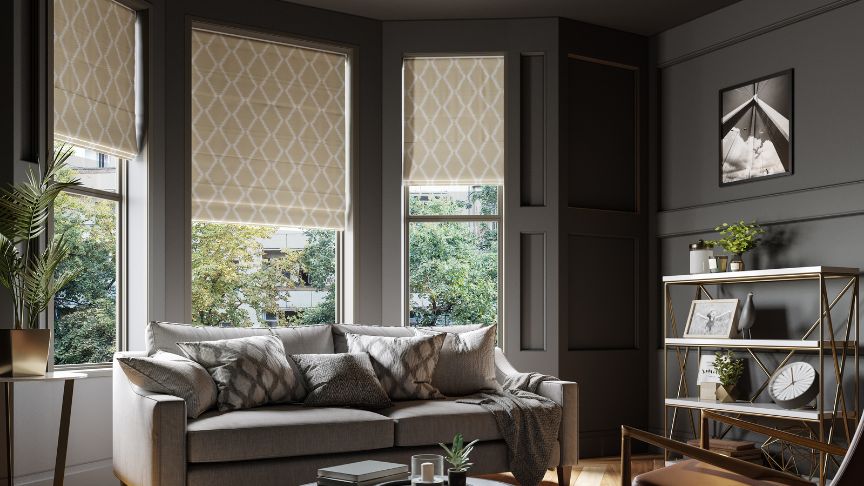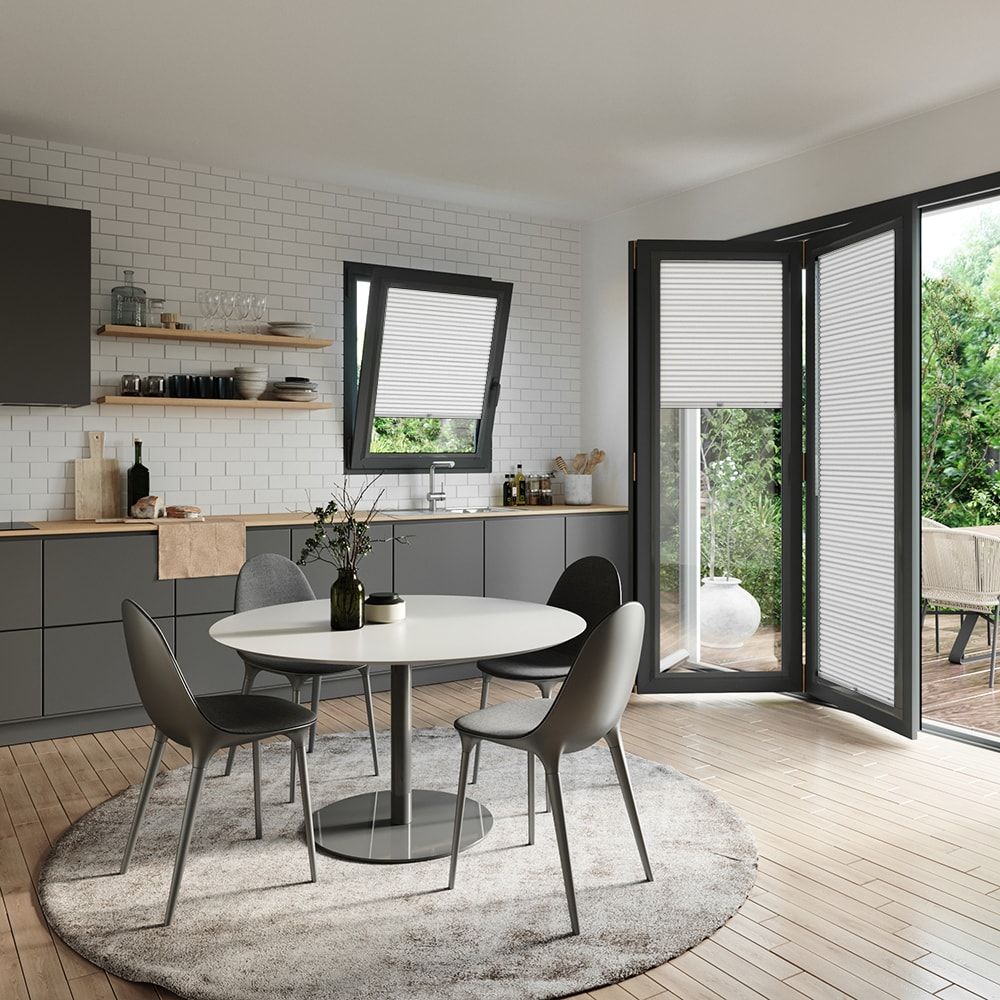Our goal is to make buying blinds simple. It’s a straightforward goal, but it is hard work when there are so many different styles to choose. This guide will change that. By the time you finish reading, you will become an expert on the different window blinds.
If there is a specific type of blind that you’re interested in, then feel free to skip ahead by using one of the links below:
1. Venetian Blinds
Venetian blinds are made from aluminium, real wood, or faux wood. To keep things simple, we will call them aluminium blinds or wooden blinds for short.
At the top of any venetian blind is the headrail where the control mechanism is housed. Our wooden blinds also include a decorative valance that matches the slats. Regardless of which option you choose, they both include two controls:
- One control for tilting the slats
- Another to raise and lower them
You will also find that wooden blinds are available with decorative tapes - we will call them taped blinds. That’s simple enough – right?
Benefits of Venetian Blinds
Venetian blinds are a jaw dropping alternative to window shutters and come at a fraction of the price. Thanks to their slat control, they offer unmatched control over light entering your room. That makes venetian blinds great on windows that are north facing with very little light, south facing with lots of light, or east and west that change throughout the day.
Disadvantages of Venetian Blinds
While these blinds block a lot of light, they are not blackout blinds. Even when the blinds are fully closed, they’ll let low levels of light through each slat. If you’re the type to need a completely dark room for sleep – consider other options.
Another disadvantage only applies to taped blinds. The tapes are made from fabric which isn’t ideal for damp or wet environments such as the kitchen or bathroom. If you are looking to fit blinds in these rooms then we strongly recommend a choice without tapes.
2. Roller Blinds
Roller blinds are a type of fabric blind that come in a choice of one or two rollers. We call them roller blinds and double roller blinds for simplicity. When using two rollers we add a voile layer to reduce glare if the sun is too bright, but it’s paired with a blackout layer for night-time.
A less common type of roller blind is the day and night blind, which is sometimes called zebra blinds or duo blinds. We will stick with day and night blinds to keep it simple. Day and night blinds are a single fabric made from a complex weave of voile and blackout strips. As you unroll the blinds the blackout strips overlap to block the sun – giving you control over the light entering the room.
Benefits of Roller Blinds
Roller blinds are one of the most versatile choices for blinds. They can come in a variety of different fabrics, light filtration, colours, and patterns. Perhaps the most versatile fabric is PVC. It is naturally flame retardant, waterproof, easy-to-wipe, and sturdy – making it great in any room.
A unique benefit of day and night blinds is their enhanced light control. It’s not quite as effective as venetian blinds, but they offer a strikingly bold look to the room. If you are going for a soft light, then these will work great – but avoid them in bedrooms or nurseries.
Disadvantages of Roller Blinds
While roller blinds can come in great blackout options, hundreds of colours, and match almost any room – even the day and night option can’t match venetian blinds for light control. Choosing a double roller or day and night option will give more control, but they are more expensive.
Roller blinds are also a poor choice for energy efficiency. To roll up seamlessly they are made from a very thin fabric. If you want to fit an unheated conservatory, you should choose pleated or venetian blinds as an alternative.
Lastly, over many years of being curled around a roller, these blinds eventually begin to warp. This warping of the fabric can make even the most modern of rooms look dated.

3. Roman Blinds
Roman blinds are a luxurious choice for covering a window. Made from a thicker fabric than roller blinds, they have rods sewn inside to create even folds. As you pull the cord, these blinds neatly unfold from the top of the window.
Since the blinds aren’t wrapping around a roller, they are available in a wide range of fabrics and textures. This adds a whole other dimension to your blinds. What’s more is that they also have a variety of linings such as blackout or thermal to choose.
Benefits of Roman Blinds
Roman blinds are a great choice for during the winter when you need thermal blinds with lining and a smart way to introduce energy efficiency in your home. Like roller blinds, their fabrics come in an enormous range of colours, patterns, and light-filtering choices.
Disadvantages of Roman Blinds
Roman blinds are never a good choice for damp environments such as kitchens or bathrooms. Even an easy to clean fabric will eventually fall to mould, grease, and odours. If you’re looking for a fabric blind in these rooms, consider a PVC Roller which will be much easier to maintain.
Aside from being unsuitable for bathrooms and kitchens, we can’t neglect to mention that their luxurious design comes at a premium cost. These eye-catching blinds come with a premium price to fit each window.

4. Pleated Blinds
Pleated blinds are another great choice of fabric blind. It works by having a fabric that folds open and closed. A single pleated fabric is the simplest design, but they’re also available in honeycomb or cellular patterns. You might find that some websites separate them, but we’ve tried to keep it simple and grouped them all together.
Pleated blinds look great and are sold as part of our Perfect Fit range of blinds that attach directly to the window frame without screws or drilling. When set up correctly, these blinds look absolutely stunning on windows and doors.
Benefits of Pleated Blinds
All our pleated blinds use a tab to open and close the blinds instead of a cord. Why is that important? Cords present a potential hazard for young children, particularly in areas where they’re easily reached by curious hands. This makes pleated blinds ideal for full-size windows or doors.
Disadvantages of Pleated Blinds
Not all window frames can support a pair of our Perfect Fit blinds, which means that sometimes pleated blinds simply aren’t an option. Pleated blinds are also more expensive than other choices. But if you can afford them, these blinds compliment modern décor.

5. Vertical Blinds
Vertical blinds function a lot like venetian blinds in their design. Instead of being horizontal, they’re vertical – but it’s the same concept. Opening them is easy with two cords to the side that slide the vanes across the headrail and kept together by chains at the bottom.
Unlike venetian blinds, the fabric of a vertical blind is much thinner and allows for better overlap. This means that they come available in either dimout or blackout options.
Benefits of Vertical Blinds
Vertical blinds are perhaps the most affordable choice for full-size windows and doors. Whether it’s a sliding door or a French door; their simple design makes them excellent candidates. Like most other fabric blinds they come in an array of colours to choose.
Disadvantages of Vertical Blinds
Vertical blinds are typically chosen to cover large areas, so when it comes to cleaning them, you need to wipe each vane separately. In their defence a large surface area would always be harder to clean, but it would be much easier with a single fabric such as roller blinds.
Love All Your Options
We hope this article helped clarify all the different types of blinds. There’s still a lot more to consider when it comes to choosing the right style and right colour – but hopefully this article simplified it.
If you found this article helpful, then please consider sharing it and spreading the knowledge.

